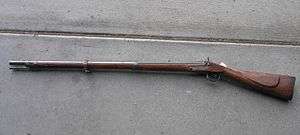Model 1814 common rifle
| United States Model 1814 rifle | |
|---|---|
|
An R. Johnson made US Model 1814 rifle. Johnson was one of two gunsmiths or manufacturers to turn out the Model 1814, the other being Henry Deringer. Note the rifle lock; this rifle was converted to percussion cap. The original would have been a flintlock. The percussion-cap lock still has Johnson's name engraved on it. | |
| Type | Rifle |
| Place of origin |
|
| Service history | |
| Used by |
|
| Wars | Seminole Wars, Civil War |
| Production history | |
| Designer | Henry Deringer |
| Designed | 1814 |
| Manufacturer | Gunsmiths Henry Deringer, R. Johnson |
| Produced | 1814– |
| Specifications | |
| Length | 49 inches (1,200 mm) |
| Barrel length | 33 inches (840 mm) |
| Width | 2.75 inches (70 mm) |
| Height | 7 inches (180 mm) |
|
| |
| Cartridge | .54 ball, black powder, paper |
| Caliber | 0.54 inches (14 mm) |
| Action | flintlock, muzzle-loaded |
| Rate of fire | 2–3 per minute |
| Feed system | muzzle |
The U.S. Model 1814 rifle was designed by Robert T. Wickham. The manufacturing was contracted out to Henry Deringer and R. Johnson to make rifles for use by the military.
Types
- Wickham type
This was the U.S. Model 1814 rifle designed by Robert T. Wickham.[1] Two manufacturers made this type, Henry Deringer of Philadelphia and R. Johnston of Connecticut.[1] Wickham sent the pattern to Deringer with a contract for 1000 rifles. One of Deringer's rifles was then sent to R. Johnson to be duplicated, with a contract for 1000 more. It was mounted with iron and had an oval patch box. It had a 33 inch barrel, octagon near the flintlock, turning to round, and using a .54 caliber bullet.[1]

- Pre-production rifles
Not the Model 1814, but a rifle of Deringer's design. It was closer to a Pennsylvania–Kentucky style rifle than a military styled rifle.[2] Deringer began making these rifles for the army before winning the 1814 contract making 51 rifles that were accepted for military service.[2] One example of these rifles survives today.[2] Unlike the Wickam type, the pre-production model was not iron mounted.[2] The rifle is full stocked, with a 38 inch barrel that is octagon near the flintlock and becomes round about a third of the way down the barrel. It had a long-rectangular bronze patch box mounted in the buttstock.[2]
- Indian rifle
A smoothbore version was also under contract with the government as a trade rifle, for sales to the Native Americans. The government wanted approximations of long rifles, but did not want them to have rifled weapons.[3]

Use during the Civil War
The rifles saw use during the Civil War. Co. A of the 2nd Mississippi Infantry carried these rifles, converted to percussion cap.[4]

See also
- List of individual weapons of the U.S. Armed Forces
- 1792 contract rifle – for the earlier process for producing firearms
- Harpers Ferry Model 1803
- Model 1817 common rifle
References
- 1 2 3 The American Rifle Shop, Inc. "1814 Common Rifle (516 A)". Retrieved 2011-12-19.
- 1 2 3 4 5 Professor Charles W. Thayer, Emeritus. "Thayer Americana, Deringer's FIRST US military rifle". Retrieved 2011-12-19.
- ↑ Dr. William L. Roberts, THE AMERICAN LIBERTY COLLECTION; #34. "NRA National Firearms Museum, U.S. Henry Deringer Model 1814 Common Rifle". Retrieved 2011-12-19.
- ↑ Dave Hunter. "Notes on the Weapons and Accouterments – Company A, 2nd Mississippi Infantry". Retrieved 2011-12-19.

